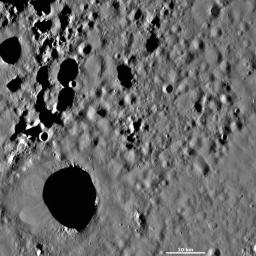This Dawn framing camera (FC) image of Vesta shows Scantia crater, which is the large crater in the bottom left corner of the image. Scantia is approximately 20 kilometers (12 miles) in diameter and has a reasonably degraded rim. On the left side of Scantia there are two areas of material that are slumping towards the crater's center. The tops of these slumping areas are rounded, so it is possible that they were originally impact craters that were formed after projectiles hit the slope of Scantia. There are many smaller craters surrounding Scantia, which have different states of preservation and freshness. There are also chains of craters and linear grooves, which are less than 1 kilometer (0.6 mile) wide, running diagonally across the bottom right corner of the image.
This image is located in Vesta's Floronia quadrangle, in Vesta's northern hemisphere. NASA's Dawn spacecraft obtained this image with its framing camera on Sept. 30, 2011. This image was taken through the camera's clear filter. The distance to the surface of Vesta is 700 kilometers (435 miles) and the image has a resolution of about 62 meters (203 feet) per pixel. This image was acquired during the HAMO (high-altitude mapping orbit) phase of the mission.
The Dawn mission to Vesta and Ceres is managed by NASA's Jet Propulsion Laboratory, a division of the California Institute of Technology in Pasadena, for NASA's Science Mission Directorate, Washington D.C. UCLA is responsible for overall Dawn mission science. The Dawn framing cameras have been developed and built under the leadership of the Max Planck Institute for Solar System Research, Katlenburg-Lindau, Germany, with significant contributions by DLR German Aerospace Center, Institute of Planetary Research, Berlin, and in coordination with the Institute of Computer and Communication Network Engineering, Braunschweig. The Framing Camera project is funded by the Max Planck Society, DLR, and NASA/JPL.
More information about the Dawn mission is online at http://www.nasa.gov/dawn and http://dawn.jpl.nasa.gov.

 Planetary Data System
Planetary Data System












